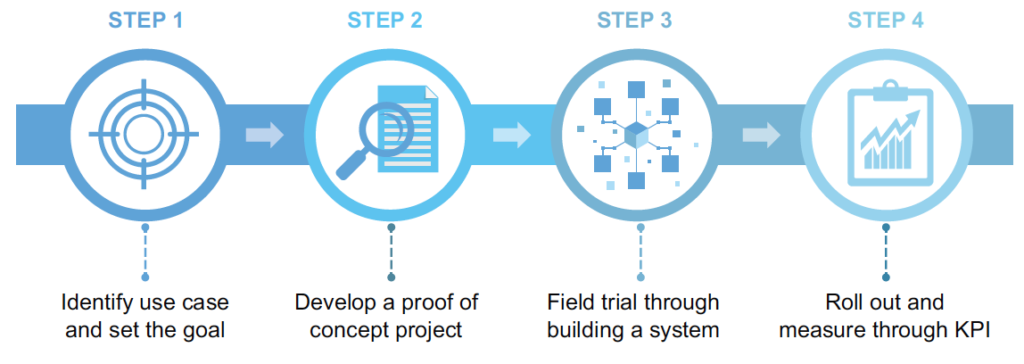Knowledge Byte: 4 Steps to Create and Implement Blockchain

Cloud Credential Council (CCC)

According to a study by Deloitte, 92% of the 26,000 blockchain-based projects that have been created between 2016 and 2018 are now dead. It is important thereafter, that every organization understands its requirements and must have a complete plan to move its production.
The steps to create and implement blockchain are the following:

- Identify the use case and set the goal: Implementing blockchain will require the help of your whole organization. Therefore, from the start, it is important to have the key stakeholder identified and involved and moreover, educated about blockchain concepts. It is important to identify the areas of the organization that can leverage the blockchain technology to gain value. Discuss user cases, identify achievable goals, and define a plan. At this stage of the cycle, organizations should inspect aspects of business process and determine areas, such as:a) Where can blockchain help eliminate their intermediaries to improve efficiency?
b) Can blockchain be used to improve the audit system? If yes, how should the problem be approached?
c) How to provide more value to customers using blockchain transparency?
d) Does moving into cryptocurrency make sense for their business model? If yes, how will this work?Through brainstorming, the team should come up with potential uses of blockchain requirements for their particular business. - Develop a proof of concept project: Team input will help create valuable ideas. But ideas need to be tested for viability. At this stage, investing a huge amount of time, money, and resources in a project might be counterproductive. It’s better to take an incremental approach. Take the ideas and try to build a Proof of Concept (PoC) project where it can validate the key ideas in a real-world scenario. It cannot be creating a full-fledged application. The PoC project should only involve the bare essentials. It should be a prototype of the applications that are to be developed at the end. Once the prototype is sketched out, set the project release date and make sure to get it tested and evaluated.
- Field trial through building a system: In order to evaluate the ideas, there is no substitute for real-world trials. It needs to build the prototype for testing. As the team has the technical expertise and know-how, it can be built internally. In case if the team is of contractors, there might be vendors who have already created blockchain solutions for each industry.
- Roll out and measure through KPI: Before rolling out the PoC prototype, get the buy-in from the stakeholders and agree on the Key Performance Indicators (KPI) and benchmark for the new system. This process will help the team.
Courses to help you get
results with Blockchain
Blockchain Foundation™
The industry-recognized CCC Blockchain Foundation provides various practical exercises that allow you to experience two of the most popular cryptocurrencies – Bitcoin and Ethereum. The course’s exposure to real-life blockchain and crypto trading ensures the knowledge you gain is ready to be implemented.
Never miss an interesting article
Get our latest news, tutorials, guides, tips & deals delivered to your inbox.
Keep learning

Knowledge Byte: Understanding Blockchain 101
Despite its increasing popularity and demand, it's far from easy to understand what Blockchain actually entails to those who are entirely new to it. Understanding...



